There are a few other threads running about 'shed envy' and showing off our various workshops and man caves. I thought that since my workshop spreads out quite a bit I would start a seperate thread rather than hijacking one of the others 
I have been waiting for most of the last year to take some new workshop photos for my website, but the weather (and various other issues) have constantly delayed it. Since a few people have been asking recently, I took a load at the weekend. So please forgive the poor photographs, the mess and general rushed nature of the tour :sad6:
On with the tour of my Man Cave....
I don't have a single workshop, I'm now up to five plus the general outdoors! My base of operations is a 10.45 acre mixed deciduous woodland in Devon. In it I have my main workshop buildings, where I do my day-to-day work and teach up to two people at a time. I also have a group teaching area comprising of an outdoor green woodworking set up and my Historical Forge School (makes it sound posh!), where I teach up to 8 people at a time.
First up, My main workshop:
The main building is 5x11m, the dry room (mucky brown building on the end) is 3x7m(ish) and between them is the heat treating room at 1.5x5m. The box on the front of the building houses my forge blower and the paving slab is where I true up waterstones.
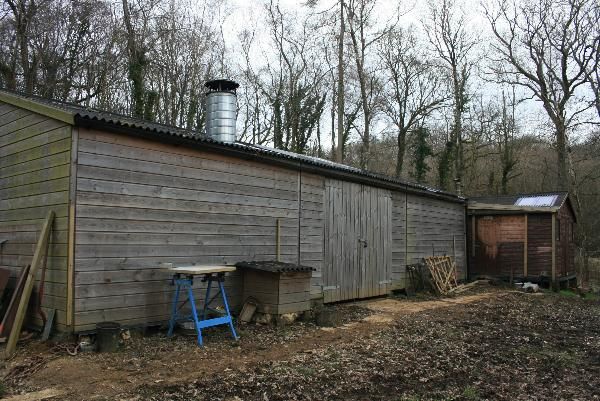
Rear view. Racks on the back of the mian building for steel and seasoned ash (cut for bows, but not used so become tool/axe handles). Propane for the heat treating furnaces. The small extension at the far end is the power house.
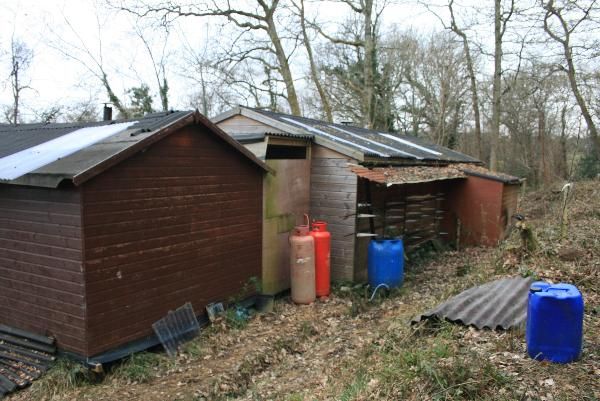
Before I take you inside the main workshop, here is a view of my power house. In it I have a 7.5Kva lister generator and a small bank of batteries, which are linked to a modest array of solar panels on the roof. My workshop is 100% off grid, this is by neccesity not desire (believe me, I would LOVE to be back on mains!)
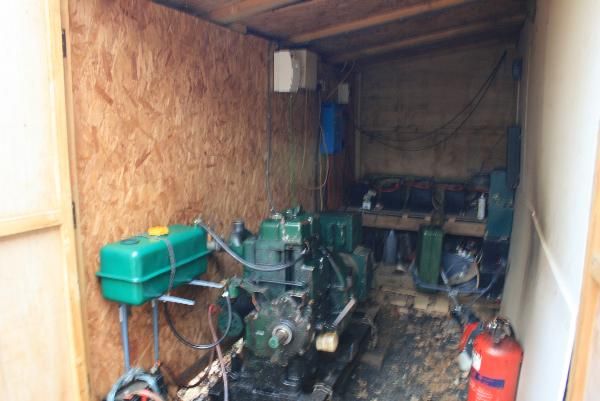
Ok, into the man cave...
Central workbench, full of junk and projects in the works. Dotted around the shot you can see my wood lathe, bench grinder, metal shears, bandsaws, forge and anvil (also my chainsaw, it doesn't live there but I had just been out cutting firewood!)
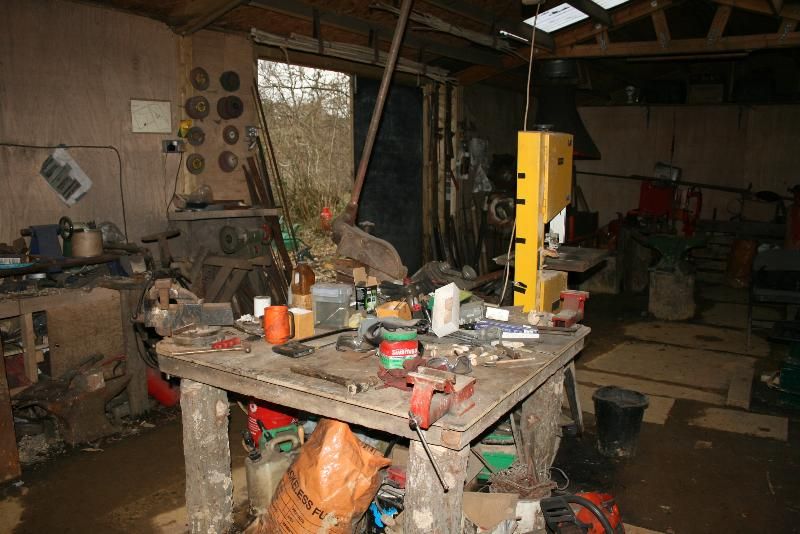
Swinging around to the left, we have my secondary workbench (where I do most of my angle grinder work), again cluttered with stuff. A couple of angle grinders, inverter welder, small belt grinder etc on the bench. Above the bench you can see the digital readouts for my heat treating, this way I can keep an eye on the temperatures whilst still getting on with some work The cupboards in the walls contain files on the far right, spanners/wrenches/pliers/small hammers on the centre right, saws on the centre left and clamps to the far left (just out of shot). The blackboard to the right is a cupboard door where my turning tools are kept next to the lathe
The cupboards in the walls contain files on the far right, spanners/wrenches/pliers/small hammers on the centre right, saws on the centre left and clamps to the far left (just out of shot). The blackboard to the right is a cupboard door where my turning tools are kept next to the lathe
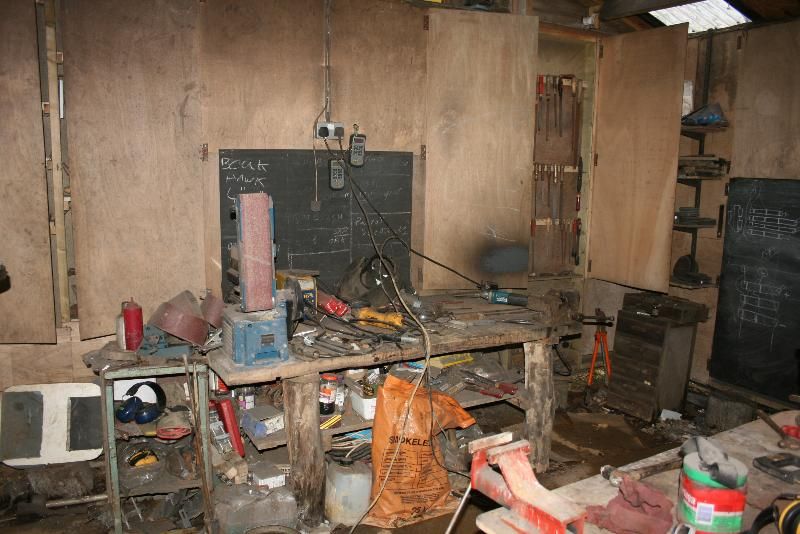
Taken from the other side of the central bench. Here are my wood and metal cutting bandsaws and shears in the front. Behind are my new baby power hammer, welding forge (the one I make damascus in), another small belt grinder and then my main grinder, hidden in the far right is my piller drill.
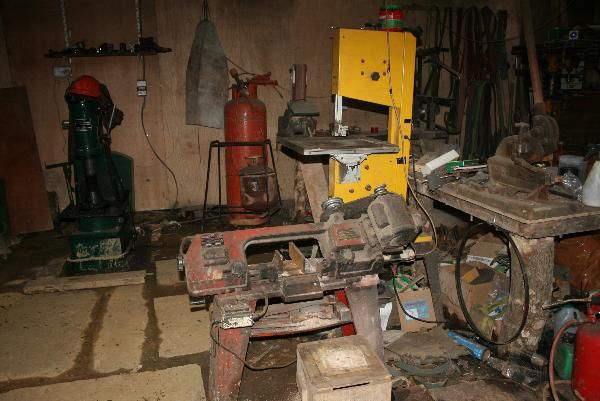
couple of intimate shots of two big boys toys. My grinder, when shiny and new, and my baby power hammer. This hammer is pretty much as small as they come and with my woeful power supply is a push to start it
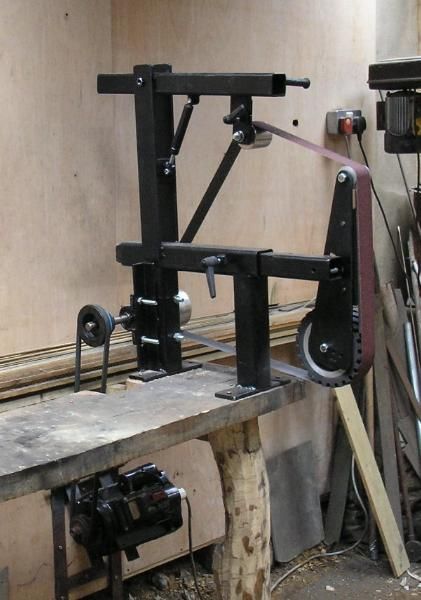
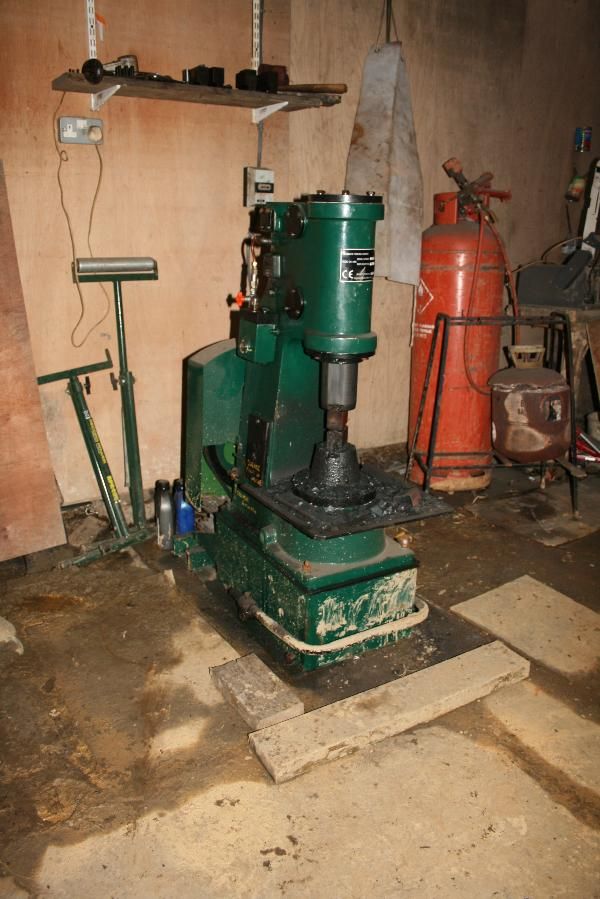
Left again, my swage blocks. The one to the right is a general purpose block and is used when punching and drifting holes (such as axe eyes), curving metal to make shapes such as bowl adze, etc. The block to the left is a special one designed by a friend and is used to form spoons, ladles and has a variety of other curves that are handy when the other swage block jsut doesn't quite work
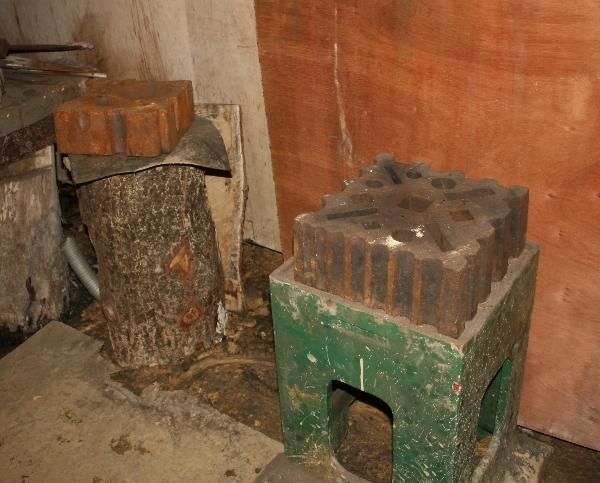
My flypress. This tool is fantastic, it cuts, it bends, it punches holes, it stamps things, etc; mostly I use it for stamping my makers mark and for drawing stock out when the power hammer isn't running (and before I got it was the only sane way I could make axes and damascus!). To the left of that we have cupboards containing my adhesives, acids (and other interesting chemicals), bronze casting supplies and small axes (big axes are stood next to the cupboards). Above the cupboards are racks where I keep my forging hammers, top tools, swages and bottom tools, flypress tools and small anvils and stakes.
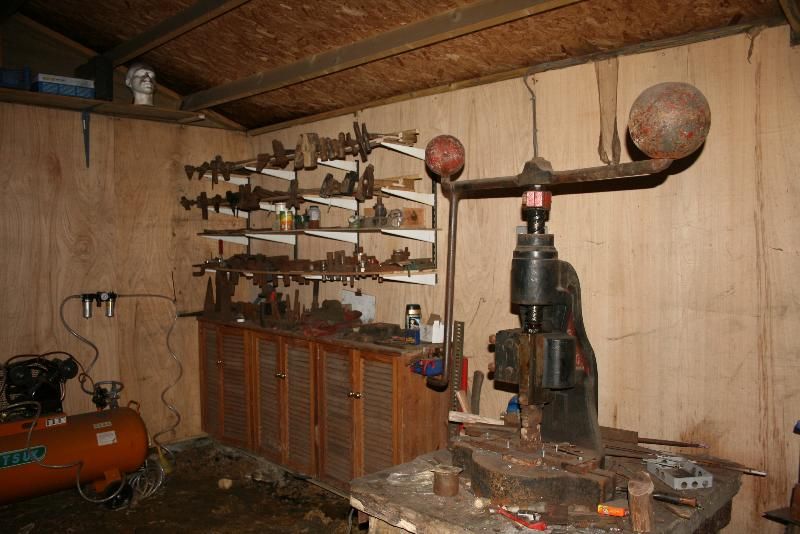
Next a couple of new toys that I need to make earn their cost. A big compressor and a pneumatic planishing hammer. The hammer is mainly used for beating sheet metal (such as car bodies), thus far I have made a few spoons and a small bowl on it; thankfully it was going cheap and so didn't really cost me anything!

To go with the compressor I have a sand blasting cabinet. I've had a little play and there will be some interesting finishes applied to things in the future
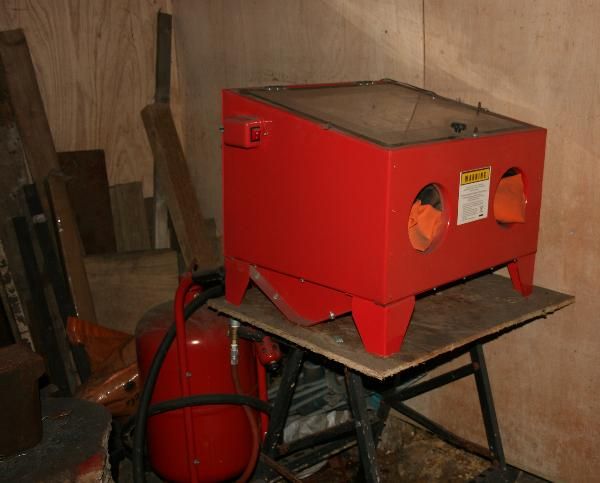
Here, at last is the forge I mostly use the rectangular stump anvil in the distance but the big green anvil gets used for straighting,bending and when the various features of the London pattern come in handy. A third anvil is mounted just off shot to the right and is used when I have two students in the workshop. The leg vice (I have many vices, if you've been counting then this is number 5, a 6th is in the corner here) is mounted on a post set over 2 feet in the ground. The anvils are all on oak sunk 3 feet in the ground (the trees once stood on the footprint of the building). The metal drums stacked behind the forge are gas forges, the small one is what I use for forging kitchen knives and the large one was an early first attempt and is a little more thirsty on gas.
I mostly use the rectangular stump anvil in the distance but the big green anvil gets used for straighting,bending and when the various features of the London pattern come in handy. A third anvil is mounted just off shot to the right and is used when I have two students in the workshop. The leg vice (I have many vices, if you've been counting then this is number 5, a 6th is in the corner here) is mounted on a post set over 2 feet in the ground. The anvils are all on oak sunk 3 feet in the ground (the trees once stood on the footprint of the building). The metal drums stacked behind the forge are gas forges, the small one is what I use for forging kitchen knives and the large one was an early first attempt and is a little more thirsty on gas.
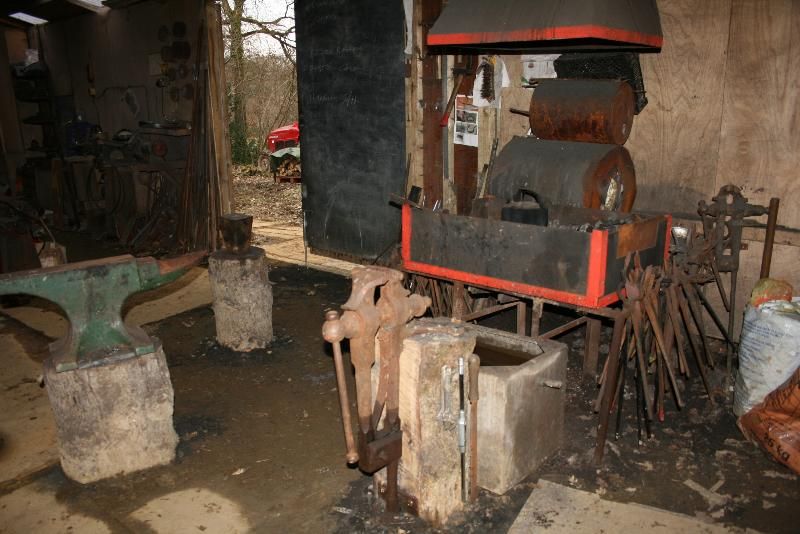
Moving along...
On the way to the dry workshop is the heat treating room. In here I have two purpose built gas funaces, running on propane. The bottom one runs stable within 2 degrees C from about 250C upto over 1100C (the hottest I need for the steels I use is 950C). The top one is for tempering and stays between 150C and about 350C. The seperate furnaces means that I can have the tempering oven up to temperature and ready for when a blade is hardened. The tank on the floor contains a commercial medium speed quenching oil and is preheated with a small blowtorch. The leads going into the wall go to the digital readouts in the other room.
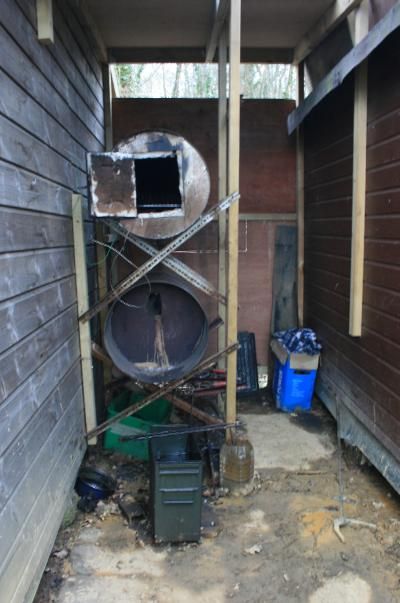
Into the warm and dry for a bit...
This is where I do my leatherwork, store handle materials and am now doing my jewellery making. It is insulated and has a woodburner to keep the place dry and warm when I want to be in there. It is also very much my space, so is a real mess right now!
First up, a work in progress jewellery corner. Rollingmill, pliers, shiny swages, mandrels, and draw plates. Wire, beads, wax for casting and silicon rubber for moulds.
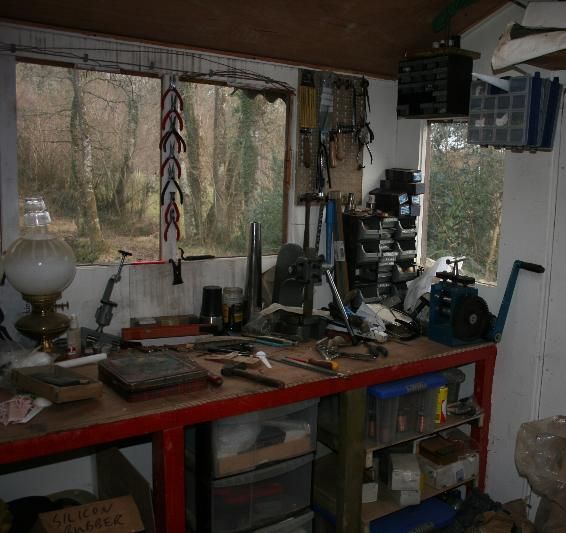
Working along that same bench we have leather dyes and finishes, this is normally clear and is where I dye sheathes. Under the bench is steel that I need to keep rust free; this is mostly pattern welding steels and O1 ground flat stock. There are also some flatbows from a few courses that I was planning to finish up to sell this winter, along with a thousand and one other things!

At the end of the room we have part of my library with books pertaining to various aspects of my work. This is a useful resource for me to have on hand and also when teaching, everything from woodland management to knifemaking is covered here. Next to the books I have magnifiers, microsopes and the like. On the bench I have a battery for my LED lighting (I can also run it from the main battery bank) and my Rockwell hardness tester. Under the bench is cut handle materials, mostly wood but to the left I have boxes with horn, antler and various synthetics (such as micarta and the fabric to make more). I have a fold up table (off to the right somewhere) that gets pushed up to this bench and I roll out leather to be cut on.
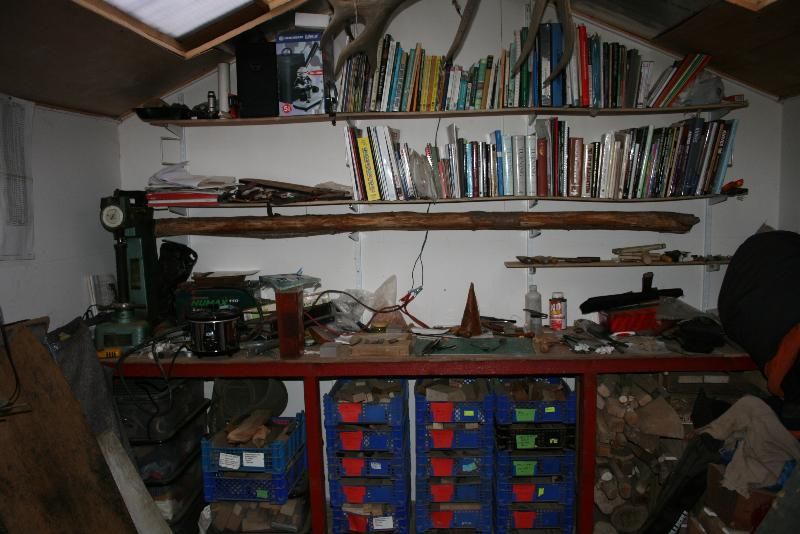
For a bit of warmth, my woodburner. I picked it up cheap on ebay and then spent a day remaking it so that it worked properly On the shelf are some 'stone' moulds for bronze casting, just drying out.
On the shelf are some 'stone' moulds for bronze casting, just drying out.
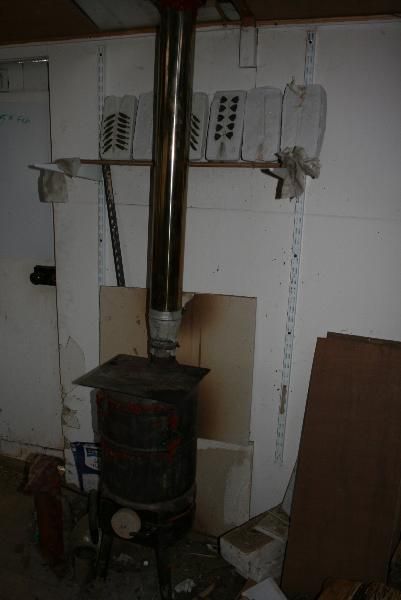
This area is also normally clear. It is where I keep most of my leatherworking tools and do any stamping and riviting. Underneath the bench is a cupboard containing various rolls of leather in a range of thicknesses. The vice count shown in pictures is now up to 8
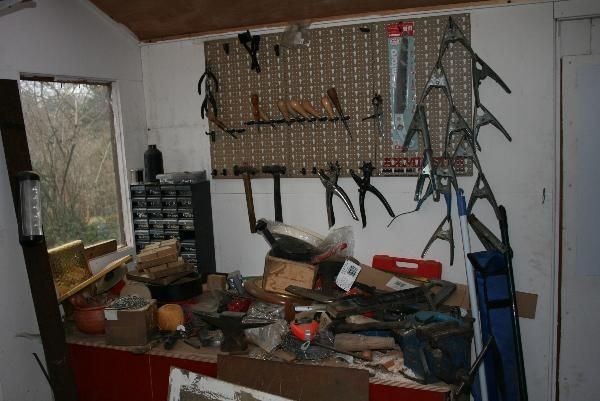
Back outside and across the woods to my outdoor playground
Here is my outdoor forging area, or Historical Forge School (that's how one group referred to it recently!). This is where I run my group forging courses, such as knife making and axe making. I currently have a Roman/Saxon forge (the one to the left), a 13th century forge (centre) and a 'modern' metal forge with hand cranked blower (on the right). I have also in the past used my Iron Age forges for teaching groups, but after several years of people moaning about sitting down all day I gave up and built the above ground versions Each forge has two anvils (of my own making) , a hardy plate for fitting anvil tools to and easy access to a leg vice. In total there are 7 vices currently. I started to extend the workshop during my last working party, but ran out of materials. The rain then came for the whole of last year so I couldn't bring any in. So I have temporarily finished it off with a tastful green tarp.
Each forge has two anvils (of my own making) , a hardy plate for fitting anvil tools to and easy access to a leg vice. In total there are 7 vices currently. I started to extend the workshop during my last working party, but ran out of materials. The rain then came for the whole of last year so I couldn't bring any in. So I have temporarily finished it off with a tastful green tarp.

Last working area, the greenwood working spot. Actually this area is due to move to a new location, with some new toys to be added. I have half a dozen shave horses, a cleaving break, two shaving breaks, four tillering points for bowmaking and 5 posts for carving with axes.

Fancy a brew? Here is a very sad and empty campfire area with a few benches (I did have some fancy cane chairs, but they have finally rotted away after 4 years of service in the woods) and a woodstore behind. I have a parachute that goes up when I have a large gathering.

A little bit of clearing that has been going on this winter
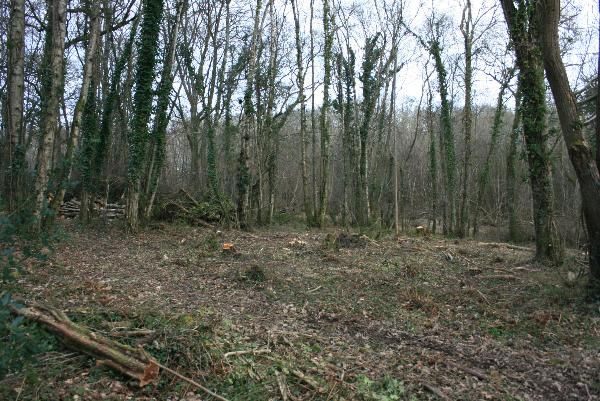
and just because he is there, a picture of a little friend in the woods
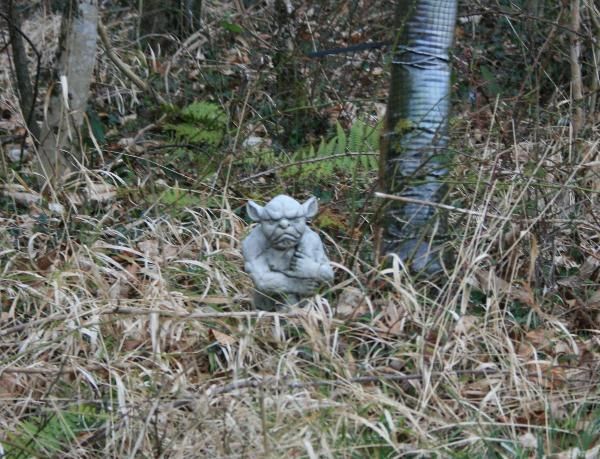
Hopefully that tour didn't exhaust you, more likely it bored you to tears and you have probably moved away to a different thread already! As each year goes by I get new toys, sorry tools, and construct more infrastructure to make Dave Budd World more fun. In the pipeline for this year (funds and weather permitting) are to finish the extension to the outdoor forge area, a porch out the front of my main workshop and a shed load of drainage!
As each year goes by I get new toys, sorry tools, and construct more infrastructure to make Dave Budd World more fun. In the pipeline for this year (funds and weather permitting) are to finish the extension to the outdoor forge area, a porch out the front of my main workshop and a shed load of drainage!
I have been waiting for most of the last year to take some new workshop photos for my website, but the weather (and various other issues) have constantly delayed it. Since a few people have been asking recently, I took a load at the weekend. So please forgive the poor photographs, the mess and general rushed nature of the tour :sad6:
On with the tour of my Man Cave....
I don't have a single workshop, I'm now up to five plus the general outdoors! My base of operations is a 10.45 acre mixed deciduous woodland in Devon. In it I have my main workshop buildings, where I do my day-to-day work and teach up to two people at a time. I also have a group teaching area comprising of an outdoor green woodworking set up and my Historical Forge School (makes it sound posh!), where I teach up to 8 people at a time.
First up, My main workshop:
The main building is 5x11m, the dry room (mucky brown building on the end) is 3x7m(ish) and between them is the heat treating room at 1.5x5m. The box on the front of the building houses my forge blower and the paving slab is where I true up waterstones.

Rear view. Racks on the back of the mian building for steel and seasoned ash (cut for bows, but not used so become tool/axe handles). Propane for the heat treating furnaces. The small extension at the far end is the power house.

Before I take you inside the main workshop, here is a view of my power house. In it I have a 7.5Kva lister generator and a small bank of batteries, which are linked to a modest array of solar panels on the roof. My workshop is 100% off grid, this is by neccesity not desire (believe me, I would LOVE to be back on mains!)

Ok, into the man cave...
Central workbench, full of junk and projects in the works. Dotted around the shot you can see my wood lathe, bench grinder, metal shears, bandsaws, forge and anvil (also my chainsaw, it doesn't live there but I had just been out cutting firewood!)

Swinging around to the left, we have my secondary workbench (where I do most of my angle grinder work), again cluttered with stuff. A couple of angle grinders, inverter welder, small belt grinder etc on the bench. Above the bench you can see the digital readouts for my heat treating, this way I can keep an eye on the temperatures whilst still getting on with some work

Taken from the other side of the central bench. Here are my wood and metal cutting bandsaws and shears in the front. Behind are my new baby power hammer, welding forge (the one I make damascus in), another small belt grinder and then my main grinder, hidden in the far right is my piller drill.

couple of intimate shots of two big boys toys. My grinder, when shiny and new, and my baby power hammer. This hammer is pretty much as small as they come and with my woeful power supply is a push to start it


Left again, my swage blocks. The one to the right is a general purpose block and is used when punching and drifting holes (such as axe eyes), curving metal to make shapes such as bowl adze, etc. The block to the left is a special one designed by a friend and is used to form spoons, ladles and has a variety of other curves that are handy when the other swage block jsut doesn't quite work

My flypress. This tool is fantastic, it cuts, it bends, it punches holes, it stamps things, etc; mostly I use it for stamping my makers mark and for drawing stock out when the power hammer isn't running (and before I got it was the only sane way I could make axes and damascus!). To the left of that we have cupboards containing my adhesives, acids (and other interesting chemicals), bronze casting supplies and small axes (big axes are stood next to the cupboards). Above the cupboards are racks where I keep my forging hammers, top tools, swages and bottom tools, flypress tools and small anvils and stakes.

Next a couple of new toys that I need to make earn their cost. A big compressor and a pneumatic planishing hammer. The hammer is mainly used for beating sheet metal (such as car bodies), thus far I have made a few spoons and a small bowl on it; thankfully it was going cheap and so didn't really cost me anything!

To go with the compressor I have a sand blasting cabinet. I've had a little play and there will be some interesting finishes applied to things in the future

Here, at last is the forge

Moving along...
On the way to the dry workshop is the heat treating room. In here I have two purpose built gas funaces, running on propane. The bottom one runs stable within 2 degrees C from about 250C upto over 1100C (the hottest I need for the steels I use is 950C). The top one is for tempering and stays between 150C and about 350C. The seperate furnaces means that I can have the tempering oven up to temperature and ready for when a blade is hardened. The tank on the floor contains a commercial medium speed quenching oil and is preheated with a small blowtorch. The leads going into the wall go to the digital readouts in the other room.

Into the warm and dry for a bit...
This is where I do my leatherwork, store handle materials and am now doing my jewellery making. It is insulated and has a woodburner to keep the place dry and warm when I want to be in there. It is also very much my space, so is a real mess right now!
First up, a work in progress jewellery corner. Rollingmill, pliers, shiny swages, mandrels, and draw plates. Wire, beads, wax for casting and silicon rubber for moulds.

Working along that same bench we have leather dyes and finishes, this is normally clear and is where I dye sheathes. Under the bench is steel that I need to keep rust free; this is mostly pattern welding steels and O1 ground flat stock. There are also some flatbows from a few courses that I was planning to finish up to sell this winter, along with a thousand and one other things!

At the end of the room we have part of my library with books pertaining to various aspects of my work. This is a useful resource for me to have on hand and also when teaching, everything from woodland management to knifemaking is covered here. Next to the books I have magnifiers, microsopes and the like. On the bench I have a battery for my LED lighting (I can also run it from the main battery bank) and my Rockwell hardness tester. Under the bench is cut handle materials, mostly wood but to the left I have boxes with horn, antler and various synthetics (such as micarta and the fabric to make more). I have a fold up table (off to the right somewhere) that gets pushed up to this bench and I roll out leather to be cut on.

For a bit of warmth, my woodburner. I picked it up cheap on ebay and then spent a day remaking it so that it worked properly

This area is also normally clear. It is where I keep most of my leatherworking tools and do any stamping and riviting. Underneath the bench is a cupboard containing various rolls of leather in a range of thicknesses. The vice count shown in pictures is now up to 8

Back outside and across the woods to my outdoor playground
Here is my outdoor forging area, or Historical Forge School (that's how one group referred to it recently!). This is where I run my group forging courses, such as knife making and axe making. I currently have a Roman/Saxon forge (the one to the left), a 13th century forge (centre) and a 'modern' metal forge with hand cranked blower (on the right). I have also in the past used my Iron Age forges for teaching groups, but after several years of people moaning about sitting down all day I gave up and built the above ground versions

Last working area, the greenwood working spot. Actually this area is due to move to a new location, with some new toys to be added. I have half a dozen shave horses, a cleaving break, two shaving breaks, four tillering points for bowmaking and 5 posts for carving with axes.

Fancy a brew? Here is a very sad and empty campfire area with a few benches (I did have some fancy cane chairs, but they have finally rotted away after 4 years of service in the woods) and a woodstore behind. I have a parachute that goes up when I have a large gathering.

A little bit of clearing that has been going on this winter

and just because he is there, a picture of a little friend in the woods

Hopefully that tour didn't exhaust you, more likely it bored you to tears and you have probably moved away to a different thread already!

 Get booked up on one of Dave's courses or help out on a wood clearing weekender & see it yourself.
Get booked up on one of Dave's courses or help out on a wood clearing weekender & see it yourself.
